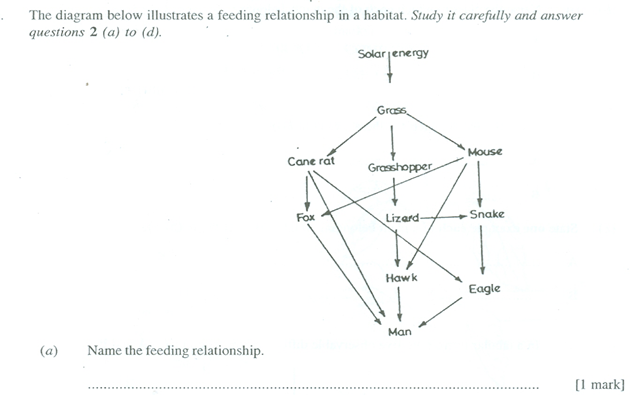Question 2
-
The diagram below illustrates a feeding relationship in a habitat. Study it carefully and answer questions 2 (a) to (d).

- Name the feeding relationship.
…………………………………………………………………………… [1 mark]
(b) Arrange the organisms in the diagram in the table below under the following sub-headings.
| Producer | Primary Consumer |
Secondary Consumer |
Tertiary Consumer |
|
|
|
|
|
|
|
|
|
|
|
|
|
|
|
|
[9 marks]
- Suggest three possible conditions that could occur if:
- Construct three possible food chains involving the mouse with two other organisms each in the diagram.
(i) More grasshoppers are introduced;
………………………………………………………………………………
………………………………………………………………………………
……………………………………………………………………………… [3 marks]
(ii) Most grasshoppers are killed.
…………………………………..............................................................................
………………………………………………………………………………….........
………………………………………………………………………………………. [3 marks]
…………………...>>>>>>>> ...................................>>>>>>>> ....................................
…………………...>>>>>>>> ...................................>>>>>>>> ....................................
…………………...>>>>>>>> ...................................>>>>>>>> ....................................
[9 marks]
Observation
This question was the most, nicely answered question. Many candidates could identify the feeding relationship as a food web. They could also arrange the organisms in the food web under the sub-headings given.
Majority of the candidates were able to construct three possible food chains from the food web.
However, despite the organisms were spelt in the food web, some students still wrote wrong spellings in the table provided. A few candidates answered question 2 (c) (i) quite satisfactorily.
Candidates who performed poorly in question 2 (d) did not start the food chains with the producer/grass.
The expected answers are:
2 (a) (i) Feeding relationship
Foodweb
(b) Table
Producer |
Primary consumer |
Secondary consumer |
Tertiary consumer |
Grass |
Cane rat |
Fox |
Hawk |
|
Grasshopper |
Lizard |
Man |
|
Mouse |
Snake |
Eagle |
|
|
Hawk |
Snake |
(c) (i) Possible conditions if more grasshoppers are introduced
- Population of grasses will reduce (drastically)/ the grass would be insufficient for the grasshoppers to eat/the rate of consumption of grasses will increase;
- Competition among grasshoppers;
- population of lizard/hawk/man/snake/eagle will increase/there will be more food for the lizard/hawk/man/snake/eagle/high growth rate of
lizard/hawk/man/snake/eagle;
- population of cane rat/fox/mouse will reduce.
(ii) Possible conditions if most grasshoppers are killed
- Population of grasses will increase;
- population of lizard/hawk/man/snake/eagle will reduce/there will be little food for the lizard/hawk/man/snake/eagle/less growth rate oflizard/hawk/man/snake/eagle;
-population of cane rat/fox/mouse/snake/eagle will increase;
- competition among the lizards/hawk for food.
(d) (i) Food chain involving mouse
Grass Mouse Hawk
Grass Mouse Snake
Grass Mouse Fox
